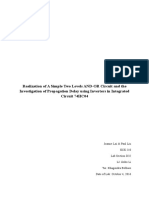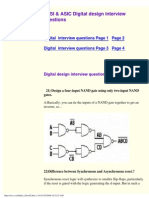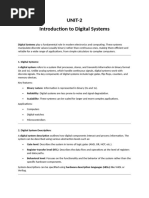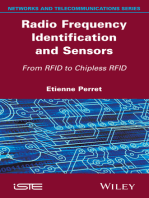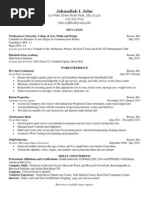Term Paper EEL (201) : Clock and Data Recovery Circuits
Term Paper EEL (201) : Clock and Data Recovery Circuits
Uploaded by
Gaurav NavalCopyright:
Available Formats
Term Paper EEL (201) : Clock and Data Recovery Circuits
Term Paper EEL (201) : Clock and Data Recovery Circuits
Uploaded by
Gaurav NavalOriginal Description:
Original Title
Copyright
Available Formats
Share this document
Did you find this document useful?
Is this content inappropriate?
Copyright:
Available Formats
Term Paper EEL (201) : Clock and Data Recovery Circuits
Term Paper EEL (201) : Clock and Data Recovery Circuits
Uploaded by
Gaurav NavalCopyright:
Available Formats
> REPLACE THIS LINE WITH YOUR PAPER IDENTIFICATION NUMBER (DOUBLE-CLICK HERE TO EDIT) <
Term Paper EEL (201):
Clock And Data Recovery Circuits
Kumar Nikhil, 4th Year Undergraduate, Mechanical Engineering Department, IIT Delhi
AbstractIn this term paper an analysis of the CDR circuit for
PLL transmission has been done. Some basic steps for design of
CDRs like transmission and phase detection have been discussed
here and also the most commonly used circuitry was analyzed by
me and the inferences hence drawn from the research.
II. TRANSMISSION
Two Types of transmitted data: Two main types of transmitted data are:--First, NRZ type (Non return to zero type)
I. INTRODUCTION
igh speed I/O is used to increase the bandwidth between
chips in a computer or network. The clock and data
recovery (CDR) module is responsible for reconstructing the
original transmitted bit-stream at the receiver. Serial data
transmission in forms of optical signals or waves leads to
distortion of the data
--Second, RZ type (Return to zero type)
Bandwidth data for NRZ data is less than that of RZ data.
Maximum bandwidth for NRZ data is 2Tb where Tb is inverse
of the bit rate (rb) or smallest time between two rising and
falling data.
Input Signal transmitted and what is received at the receiver
In many systems, data is transmitted or retrieved without any
additional timing reference. For example, in optical
communications, a stream of data flows over a single fiber
with no accompanying clock, but the receiver is required to
process this data synchronously. Therefore, the clock or
timing information must be recovered from the data at the
receiver
III. EDGE DETECTION
NRZ
EDGES
Edge Detection for NRZ data
Edge Detection can be done in several ways few of which
are given below:
Data
1) Making use of delay:
Din
Recovered Clock
Data and recovered clock
Mostly all clock recovery circuits employ some form of a
PLL. Following are the steps and some basic concept that
during my research of the topic I understood.
Dout
In line 2 we need to add a delay delta by any way we want.
> REPLACE THIS LINE WITH YOUR PAPER IDENTIFICATION NUMBER (DOUBLE-CLICK HERE TO EDIT) <
V. CODE DISPARITY
2) Differentiator and full wave rectifier:
3) Using flip flops: A Double Edge triggered flip flop can be
used for edge detection. Circuitry involved is shown in the
following diagram.
In an unbalanced code the disparity is can be without limits
but in balanced code since we put a bound to disparity it has a
maxima, which it cannot cross.
VI. PHASE DETECTION
I would be discussing only Linear Phase Detectors because
of the fact that I didnt understand the other types. Following
is a circuit diagram for Hogge Detector, which is the most
widely, used circuitry for the process. This type of detector is
also called Self Correcting Detector.
XVCO
A Hogges Phase Detector
Xvco
Above two are circuits for edge detection by using D flip flops
(double edge triggered).
The diagram above labels all the ports but we give input
data at D and recovered is Dout, which is fed back to reference.
Line from Q0 to D1 is A and that from Q1 is B. Output of the
first XOR gate is up and that of the second XOR gate is down.
IV. PHASE LOCKED CLOCK RECOVERY CIRCUIT
Phase locked clock recovery circuit
If the input data is periodic with certain frequency then the
edge detector doubles the frequency and locks the PLL at that
value. Now, if the output transitions are absent then the output
of the multiplier is zero and VCO control voltage begins to
decay causing the oscillator to deviate. To minimize the
deviation LPF >>> Maximum allowable time between two
transitions.
Output of different terminals
Above data is the response of the detector for a linear data
input. For above example clock rising edge is at the data
center.
> REPLACE THIS LINE WITH YOUR PAPER IDENTIFICATION NUMBER (DOUBLE-CLICK HERE TO EDIT) <
VII. ACCOUNTING FOR JITTER
Steps to account for Jitters in clock:1.) Measure the Jitters around the clock by using following
function
2.) Multiply these components with the Filter Mask.
3.) RMS total noise voltage over band.
4.) Convert RMS noise voltage to RMS jitter.
Above diagram shows the transfer characteristics and
following is the discussion of the same for Hogges Detector
Hogges Detector has linear gain characteristics and small
jitter generation due to phase detection. Phase detection gain is
.5 for 11001100 data transition density. It has a static phase
offset due to mismatch.
The Hogges Detector subtracts two pulses, each originating
from an XOR gate. A charge pump does the subtraction
indirectly. The XOR gate on the right generates a reference
pulse that is exactly half a bit time in width. The XOR gate on
the left generates a pulse whose width depends on the phase
error between the edges of Data and the edges of Drt. When
the phase difference between Data and Drt (and hence Clock)
is half a bit, the two pulses cancel each other thus generating
no change in the PD output. The linearity results from the net
pulse width at the output being linearly proportional to the
phase difference between the center of Data and the edges of
Clock. The saw-tooth shape of the transfer function is due to
phase being a modulo-2 quantity. Phase detector gain (KPD)
is defined as the slope of the transfer function where the phase
error is close to zero. The phase detector gain is typically 1
and is unitless. This Hogges PD allows the use of Linear
Systems Theory. But due to the use of Flip Flops and Gates
the rate for operations of this PD is limited to some best
possible case (I did not get any reference anywhere to that).
In general Phase Detectors produce a DC component
proportional to the deviation of sampling point from the center
of the bit cell. Binary Sized phase detectors are also called
bang bang detectors (not presented here).
VIII. FILTER MASK USED FOR JITTER CORRECTION
Above discussed Jitter Correction method needs a fliter mask.
The circuitry for the same is
Difficulties with filters are:
1. Temperature and frequency variation causing difficulty
in delay time calculation.
2. Difficulty in building of High Q filters.
IX. FILTER MASK USED FOR JITTER CORRECTION
After discussing the basic modules of the Clock Recovery
Circuits, following are the circuitry for few methods to
draw the outputs
> REPLACE THIS LINE WITH YOUR PAPER IDENTIFICATION NUMBER (DOUBLE-CLICK HERE TO EDIT) <
REFERENCES: 1. Information on Clock and Data Recovery Circuits
Hewlett-Packard Company Palo Alto, California
2. Doctorate report submitted to Department of
Electrical Engineering and committee of Graduate
studies on Estimation of Clock and Data Recovery
systems.
3. Lecture on Clock and Data Recovery Systems by
P.E. Allen (course :- ECE 64400)
4. IEEE paper on A Digital Clock and Data
Recovery Architecture for Multi-Gigabit/s Binary
Links by Jeff Sonntag and John Stonick.
5. Wikipedia page on Clock And Data Recovery
Systems.
Vco collected is the required data recovered from the
received signal. Vco collected can be of various types but due
to space constraints I cannot discuss them all here.
X. CONCLUSION
Receiver end of communication needs a clock as well as a
jitter free data stream. CDR circuits thus come in handy. Basic
modules for steps like edge detection, phase detection are
explained and their technical aspects discussed. Circuitry for
all the steps involved in design of CDR is explained.
Discussion above is only for Linear Input Data. Transmission
of the data is also discussed very briefly. Due to the restriction
and limitation of space this was the best thing I could have
come up.
6. Mostly Images Drawn by me but few taken from
random sources from Google Images because of the
complexity.
You might also like
- Lab Report On ECE 210 Lab1Document6 pagesLab Report On ECE 210 Lab1Joanne Lai100% (3)
- Digital Design Interview Questions & AnswersDocument5 pagesDigital Design Interview Questions & AnswersSahil KhanNo ratings yet
- Digital Communication PDFDocument17 pagesDigital Communication PDFsoumojit048No ratings yet
- nternational Journal of Computational Engineering Research(IJCER) is an intentional online Journal in English monthly publishing journal. This Journal publish original research work that contributes significantly to further the scientific knowledge in engineering and Technology.Document6 pagesnternational Journal of Computational Engineering Research(IJCER) is an intentional online Journal in English monthly publishing journal. This Journal publish original research work that contributes significantly to further the scientific knowledge in engineering and Technology.International Journal of computational Engineering research (IJCER)No ratings yet
- Design of All Digital Phase Locked LoopDocument4 pagesDesign of All Digital Phase Locked LoopInternational Journal of Research in Engineering and TechnologyNo ratings yet
- Yin 2011Document11 pagesYin 2011Lâm Trần ThànhNo ratings yet
- L200 CDR I (2up)Document16 pagesL200 CDR I (2up)Nikunj JadawalaNo ratings yet
- A Question About AND Gate 41. A Question About AND Gate 42. A Question About NOR GateDocument3 pagesA Question About AND Gate 41. A Question About AND Gate 42. A Question About NOR GateDenaiya Watton LeehNo ratings yet
- A Jitter Injection Signal Generation and ExtractioDocument14 pagesA Jitter Injection Signal Generation and Extractioيبسسي سيسيسيNo ratings yet
- VLSI & ASIC Digital Design Interview QuestionsDocument6 pagesVLSI & ASIC Digital Design Interview QuestionsRupesh Kumar DuttaNo ratings yet
- A 0.5-To-2.5 Gbs Reference-Less Half-Rate Digital CDR With Unlimited Frequency Acquisition Range and Improved Input Duty-Cycle Error ToleranceDocument13 pagesA 0.5-To-2.5 Gbs Reference-Less Half-Rate Digital CDR With Unlimited Frequency Acquisition Range and Improved Input Duty-Cycle Error ToleranceMinh KhangNo ratings yet
- 6.012 ST13 Design ProjectDocument5 pages6.012 ST13 Design Projectarthur5689791No ratings yet
- Clockless ChipsDocument17 pagesClockless ChipsMandeep SainiNo ratings yet
- Digital Communication PDFDocument11 pagesDigital Communication PDFsoumojit048No ratings yet
- Lab HTSo 22eceDocument19 pagesLab HTSo 22ecenminhhoang001No ratings yet
- Elka Group AssignmentDocument4 pagesElka Group AssignmentAhmad MiqdamNo ratings yet
- Unit-2 Digital SystemsDocument27 pagesUnit-2 Digital Systemstiwariatul1016No ratings yet
- All Digital Phase Locked Loop Design and ImplementationDocument4 pagesAll Digital Phase Locked Loop Design and ImplementationAnton SaitovNo ratings yet
- Ofc Lab Manual 2Document21 pagesOfc Lab Manual 2Shobhit JainNo ratings yet
- Cpe400L 09 Experiment 9Document25 pagesCpe400L 09 Experiment 9KirubaKaran SNo ratings yet
- Injection-Locked Clock andDocument12 pagesInjection-Locked Clock andAnonymous e4UpOQEPNo ratings yet
- Dds IntroDocument6 pagesDds IntroYermakov Vadim IvanovichNo ratings yet
- Adcl-01 EXP V1.1Document12 pagesAdcl-01 EXP V1.1tom_116No ratings yet
- Design of All Digital Phase Locked Loop For WireleDocument5 pagesDesign of All Digital Phase Locked Loop For WireleKiran SomayajiNo ratings yet
- UHF Surface Dynamics Parameters Radar Design and ExperimentDocument3 pagesUHF Surface Dynamics Parameters Radar Design and ExperimentmenguemengueNo ratings yet
- Apparatus:: AIM: Acquire The Knowledge of Output Devices Like CRO and DSO For Observing OutputDocument5 pagesApparatus:: AIM: Acquire The Knowledge of Output Devices Like CRO and DSO For Observing OutputAdwait BorikarNo ratings yet
- Adpll JSSC 2007Document11 pagesAdpll JSSC 2007陳育楷No ratings yet
- Numerically Controlled Oscillator With Spur Reduction: Hans-Jörg Pfleiderer Stefan LachowiczDocument4 pagesNumerically Controlled Oscillator With Spur Reduction: Hans-Jörg Pfleiderer Stefan LachowiczRaffi SkNo ratings yet
- 4fsk DemodDocument4 pages4fsk DemodavionionNo ratings yet
- Digital Electronics Interview Questions: 1) What Is The Difference Between Latch and Flip-Flop?Document11 pagesDigital Electronics Interview Questions: 1) What Is The Difference Between Latch and Flip-Flop?yashuNo ratings yet
- Computer-Based Project in VLSI Design Co 3/7Document14 pagesComputer-Based Project in VLSI Design Co 3/7Naresh LakhaniNo ratings yet
- Answer:Spectral Efficiency, Spectrum Efficiency or Bandwidth Efficiency Refers ToDocument23 pagesAnswer:Spectral Efficiency, Spectrum Efficiency or Bandwidth Efficiency Refers ToRey BernardinoNo ratings yet
- Mod 5Document6 pagesMod 5Andrew GomesNo ratings yet
- A Digital Clock and Data Recovery Architecture Jssc2006Document9 pagesA Digital Clock and Data Recovery Architecture Jssc2006Dff NaNo ratings yet
- Ch01 Introduction To Digital SystemsDocument39 pagesCh01 Introduction To Digital SystemsOryRgbNo ratings yet
- Aguidetocommonautomationterms 110628101636 Phpapp02Document10 pagesAguidetocommonautomationterms 110628101636 Phpapp02Lawrence Okyere OforiNo ratings yet
- 117766110-PDC-Lab-Manual 4Document46 pages117766110-PDC-Lab-Manual 4Suda KrishnarjunaraoNo ratings yet
- High Resolution Time To Digital ConverterDocument5 pagesHigh Resolution Time To Digital ConverterInnybtzNo ratings yet
- UMTS Interview Questions and AnswerDocument16 pagesUMTS Interview Questions and AnswerSuhelSiddiquiNo ratings yet
- A 2.6Ps - Period-Jitter 900Mhz All-Digital Fractional-N PLL Built With Standard CellsDocument4 pagesA 2.6Ps - Period-Jitter 900Mhz All-Digital Fractional-N PLL Built With Standard CellsRichard SuNo ratings yet
- What Is The Difference Between Latch and FlipDocument10 pagesWhat Is The Difference Between Latch and FlipMarcus OluochNo ratings yet
- DVD2 JNTU Set1 SolutionsDocument12 pagesDVD2 JNTU Set1 Solutionsకిరణ్ కుమార్ పగడాలNo ratings yet
- Crosstalk Optimisation on Clock NetsDocument15 pagesCrosstalk Optimisation on Clock NetsMohit soniNo ratings yet
- Lab BookDocument70 pagesLab Bookअमरेश झाNo ratings yet
- Ring Oscillator ThesisDocument8 pagesRing Oscillator Thesisafjvbpyki100% (2)
- A 20 Gb/s INJECTION-LOCKED CLOCK AND DATA RECOVERY CIRCUITDocument12 pagesA 20 Gb/s INJECTION-LOCKED CLOCK AND DATA RECOVERY CIRCUITvlsicsjournal910No ratings yet
- Decoder2001 Armatur HorowitzDocument10 pagesDecoder2001 Armatur HorowitzNK NKNo ratings yet
- CS EXPERIMENT 11 01012021 095140am 18012021 012709amDocument13 pagesCS EXPERIMENT 11 01012021 095140am 18012021 012709amAsif AliNo ratings yet
- PLL DividerDocument6 pagesPLL Divider081270No ratings yet
- Delay Lock LoopDocument19 pagesDelay Lock LoopjameelahmadNo ratings yet
- AO Proximity Security SystemDocument31 pagesAO Proximity Security SystemSana UllahNo ratings yet
- 5988 6254ej W 2Document140 pages5988 6254ej W 2poorna434No ratings yet
- Digital Interview QuestionsDocument5 pagesDigital Interview QuestionsAnindra NallapatiNo ratings yet
- A Digitally Controlled PLL For Soc Applications: Thomas Olsson, Member, Ieee, and Peter Nilsson, Member, IeeeDocument10 pagesA Digitally Controlled PLL For Soc Applications: Thomas Olsson, Member, Ieee, and Peter Nilsson, Member, IeeeSathish KumarNo ratings yet
- TTL and CMOS FamiliesDocument7 pagesTTL and CMOS FamiliesFabian AvilaNo ratings yet
- DC Lab 2018 HandoutsDocument22 pagesDC Lab 2018 HandoutssruthyNo ratings yet
- Radio Control for Model Ships, Boats and AircraftFrom EverandRadio Control for Model Ships, Boats and AircraftRating: 5 out of 5 stars5/5 (1)
- Analog Dialogue, Volume 48, Number 1: Analog Dialogue, #13From EverandAnalog Dialogue, Volume 48, Number 1: Analog Dialogue, #13Rating: 4 out of 5 stars4/5 (1)
- Radio Frequency Identification and Sensors: From RFID to Chipless RFIDFrom EverandRadio Frequency Identification and Sensors: From RFID to Chipless RFIDNo ratings yet
- GEO L18 Soils of India Land UseDocument45 pagesGEO L18 Soils of India Land UseGaurav NavalNo ratings yet
- Jatin RAS 100120102197406Document1 pageJatin RAS 100120102197406Gaurav NavalNo ratings yet
- Press NoteDocument2 pagesPress NoteGaurav NavalNo ratings yet
- Trigonometry-Minimum Maximum ValuesDocument7 pagesTrigonometry-Minimum Maximum ValuesGaurav NavalNo ratings yet
- Viterbi DecodingDocument4 pagesViterbi DecodingGaurav NavalNo ratings yet
- Gargi Sharma Viterbi Algorithm Term Paper EEL201Document4 pagesGargi Sharma Viterbi Algorithm Term Paper EEL201Gaurav NavalNo ratings yet
- Chapter 5: Process SchedulingDocument29 pagesChapter 5: Process SchedulingGaurav NavalNo ratings yet
- Low-Voltage Low-Power Adders: Unit-IvDocument24 pagesLow-Voltage Low-Power Adders: Unit-Ivrakesh100% (5)
- DMRC Ph-Iii Sod 1Document23 pagesDMRC Ph-Iii Sod 1Sahyadree Shah100% (2)
- PSEC 105 Political EconomyDocument138 pagesPSEC 105 Political EconomyCharley Mei SorianoNo ratings yet
- Speech EnglishDocument1 pageSpeech EnglishAngela MaheswariNo ratings yet
- MorayDocument2 pagesMoraymeenaxi.aravinthanNo ratings yet
- CH 27Document9 pagesCH 27siddharthsrathor04No ratings yet
- Luting Cements Review ArticleDocument5 pagesLuting Cements Review ArticleAnubhuti SabhlokNo ratings yet
- TheConstitutionalLegitimacyofNarco AnalysisDocument5 pagesTheConstitutionalLegitimacyofNarco AnalysisGourima BabbarNo ratings yet
- Thrust Vectoring - Technical SeminarDocument20 pagesThrust Vectoring - Technical SeminarNithish Jain100% (1)
- Gen PeriyarDocument147 pagesGen PeriyarLibrary M.SelvamNo ratings yet
- macOS_IRDocument27 pagesmacOS_IRhellogamingandtechnicalNo ratings yet
- Refresher 01Document4 pagesRefresher 01breimanangNo ratings yet
- Wireless Monitoring System For Lightweight Aircraft Landing GearDocument6 pagesWireless Monitoring System For Lightweight Aircraft Landing Gear759305169No ratings yet
- 1st Periodic Test Grade 8-STEDocument5 pages1st Periodic Test Grade 8-STEBerlits BoloNo ratings yet
- Entomology 1Document4 pagesEntomology 1Ozman NovelNo ratings yet
- Jesse M. Robredo Institute of Governance and Development: Bu-Jmrigd@bicol-U.edu - PHDocument4 pagesJesse M. Robredo Institute of Governance and Development: Bu-Jmrigd@bicol-U.edu - PHEda Paje AdornadoNo ratings yet
- Chapter 1 History VocabDocument3 pagesChapter 1 History Vocabapi-242369647No ratings yet
- AI and Judicial Decision-MakingDocument18 pagesAI and Judicial Decision-MakingDeborah BACLearnNo ratings yet
- Sap Abap Error CodeDocument12 pagesSap Abap Error CodevmuthukumaarNo ratings yet
- C Fiordev 21-FBDocument16 pagesC Fiordev 21-FB97911No ratings yet
- Best PracticeDocument15 pagesBest PracticeJulie KhannaNo ratings yet
- Charlie Songhurst - Lessons From: Investing in 483 CompaniesDocument22 pagesCharlie Songhurst - Lessons From: Investing in 483 CompaniesAbcd123411No ratings yet
- The Impact of Technology Advancement On ICT Students (Group 2 Research Paper)Document5 pagesThe Impact of Technology Advancement On ICT Students (Group 2 Research Paper)ICT 11 Lemi, Arvie Paulo D.No ratings yet
- Bessel Functions of The First KindDocument5 pagesBessel Functions of The First KindRajNo ratings yet
- CFD Thesis PDFDocument5 pagesCFD Thesis PDFgjhr3grk100% (2)
- ACS604 7 Manual de HardwareDocument94 pagesACS604 7 Manual de Hardwarejuan bautista vezzosiNo ratings yet
- Meet Your Happy ChemicalsDocument9 pagesMeet Your Happy ChemicalsIvan MontNo ratings yet
- Professional ResumeDocument1 pageProfessional ResumeyoursinfitnessNo ratings yet
- The 10 Best Nootropics For Studying, Focus, and MemoryDocument20 pagesThe 10 Best Nootropics For Studying, Focus, and MemoryIvan RadoševićNo ratings yet
- Grade 9: The Second SemesterDocument10 pagesGrade 9: The Second SemesterTấn Tài VõNo ratings yet
